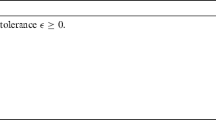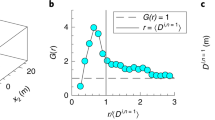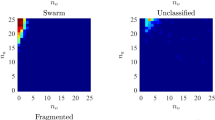Abstract
The theory of collective motion and the study of animal social networks have, each individually, received much attention. Currently, most models of collective motion do not consider social network structure. The implications for considering collective motion and social networks together are likely to be important. Social networks could determine how populations move in, split up into and form separate groups (social networks affecting collective motion). Conversely, collective movement could change the structure of social networks by creating social ties that did not exist previously and maintaining existing ties (collective motion affecting social networks). Thus, there is a need to combine the two areas of research and examine the relationship between network structure and collective motion. Here, we review different modelling approaches that combine social network structures and collective motion. Although many of these models have not been developed with ecology in mind, they present a current context in which a biologically relevant theory can be developed. We argue that future models in ecology should take inspiration from empirical observations and consider different mechanisms of how social preferences could be expressed in collectively moving animal groups.


Similar content being viewed by others
References
Bajec IL, Heppner FH (2009) Organized flight in birds. Anim Behav 78:777–789
Ballerini M, Cabibbo N, Candelier R, Cavagna A, Cisbani E, Giardina I, Lecomte V, Orlandi A, Parisi G, Procaccini A, Viale M, Zdravkovic V (2008) Interaction ruling animal collective behavior depends on topological rather than metric distance: evidence from a field study. Proc Natl Acad Sci USA 105:1232–1237
Belmonte JM, Thomas GL, Brunnet LG, de Almeida RMC, Chaté H (2008) Self-propelled particle model for cell-sorting phenomena. Phys Rev Lett 100:248702
Bode NWF, Faria JJ, Franks DW, Krause J, Wood AJ (2010a) How perceived threat increases synchronization in collectively moving animal groups. Proc R Soc B (published online). doi:10.1098/rspb.2010.0855
Bode NWF, Franks DW, Wood AJ (2010b) Limited interactions in flocks: relating model simulations to empirical data. J R Soc Interface (published online). doi:10.1098/rsif.2010.0397
Borrel V, Legendre F, De Amorim MD, Fdida S (2009) Simps: using sociology for personal mobility. IEEE/ACM Trans Netw 17:831–842
Braun A, Musse SR, de Oliveira LPL, and Bodmann BEJ (2003) Modeling individual behaviors in crowd simulation. Proc. 16th Int. Conf. Computer Animation and Social Agents, pp 143–148
Bumann D, Krause J, Rubenstein D (1997) Mortality risk of spatial positions in animal groups: the danger of being in the front. Behaviour 134:1063–1076
Buscarino A, Fortuna L, Frasca M, Rizzo A (2006) Dynamical network interactions in distributed control of robots. Chaos 16:015116
Conradt L, Krause J, Couzin ID, Roper TJ (2009) “Leading according to need” in self-organizing groups. Am Nat 173:304–312
Consolini L, Morbidi F, Prattichizzo D, Tosques M (2008) Leader–follower formation control of nonholonomic mobile robots with input constraints. Automatica 44:1343–1349
Correll N, Sempo G, Lopez de Meneses Y, Halloy J, Deneubourg JL, and Martinoli A (2006) SwisTrack: a tracking tool for multi-robotic and biological systems. Proc. IEEE/RSJ International Conference on Intelligent Robots and Systems, pp 2185–2191
Couzin ID, Krause J, James R, Ruxton GD, Franks NR (2002) Collective memory and spatial sorting in animal groups. J Theor Biol 218:1–11
Couzin ID, Krause J, Franks NR, Levin SA (2005) Effective leadership and decision-making in animal groups on the move. Nature 433:513–516
Croft DP, Arrowsmith BJ, Bielby J, Skinner K, White E, Couzin ID, Magurran AE, Ramnarine I, Krause J (2003) Mechanisms underlying shoal composition in the Trinidadian guppy, Poecilia reticulata. Oikos 100:429–438
Croft DP, Krause J, James R (2004) Social networks in the guppy (Poecilia reticulata). Proc R Soc B 271:S516–S519
Croft DP, James R, Ward AJW, Botham MS, Mawdsley D, Krause J (2005) Assortative interactions and social networks in fish. Oecologia 143:211–219
Croft DP, James R, Krause J (2008) Exploring animal social networks. Princeton University Press, Princeton
Croft DP, Krause J, Darden SK, Ramnarine IW, Faria JJ, James R (2009) Behavioural trait assortment in a social network: patterns and implications. Behav Ecol Sociobiol 63:1495–1503
Cross PC, Lloyd-Smith JO, Getz WM (2005) Disentangling association patterns in fission–fusion societies using African buffalo as an example. Anim Behav 69:499–506
De Smet F, Aeyels D (2009) Clustering in a network of non-identical and mutually interacting agents. Proc R Soc A 465:745–768
Dugatkin LA, Wilson DS (2000) Assortative interactions and the evolution of cooperation during predator inspection in guppies (Poecilia reticulata). Evol Ecol Res 2:761–767
Espmark Y (1971) Individual recognition by voice in reindeer mother–young relationship. Field observations and playback experiments. Behaviour 40:295–301
Franks DW, Ruxton GD, James R (2010) Sampling animal association networks with the gambit of the group. Behav Ecol Sociobiol 64:493–503
Frère CH, Krützen M, Mann J, Watson-Capps JJ, Tsai YJ, Patterson EM, Connor R, Bejder L, Sherwin WB (2010) Home range overlap, matrilineal and biparental kinship drive female associations in bottlenose dolphins. Anim Behav 80(3):481–486
Fridman N, Kaminka GA (2007) Towards a cognitive model of crowd behavior based on social comparison theory. Proc 22nd Natl Conf Artif Intell 22:731–737
Griffiths SW, Magurran AE (1997) Schooling preferences for familiar fish vary with group size in a wild guppy population. Proc R Soc B 264:547–551
Griffiths SW, Magurran AE (1999) Schooling decisions in guppies (Poecilia reticulata) are based on familiarity rather than kin recognition by phenotype matching. Behav Ecol Sociobiol 45:437–443
Gross T, Blasius B (2008) Adaptive coevolutionary networks: a review. J R Soc Interface 5:259–271
Helbing D, Farkas I, Vicsek T (2000) Simulating dynamical features of escape panic. Nature 407:487–490
Hemelrijk CK (2000) Towards the integration of social dominance and spatial structure. Anim Behav 59:1035–1048
Hemelrijk CK, Kunz H (2005) Density distribution and size sorting in fish schools: an individual-based model. Behav Ecol 16:178–187
Hemelrijk CK, Hildenbrandt H (2008) Self-organized shape and frontal density of fish schools. Ethology 114:245–254
Hu J, Hong Y (2007) Leader-following coordination of multi-agent systems with coupling time delays. Phys A 374:853–863
Jadbabaie A, Lin J, Morse AS (2003) Coordination of groups of mobile autonomous agents using nearest neighbor rules. IEEE Trans Automat Control 48:988–1001
Krause J, Ruxton GD (2002) Living in groups. Oxford University Press, Oxford
Krause J, Croft DP, James R (2007) Social network theory in the behavioural sciences: potential applications. Behav Ecol Sociobiol 62:15–27
Krause J, Lusseau D, James R (2009) Animal social networks: an introduction. Behav Ecol Sociobiol 63:967–973
Lemasson BH, Anderson JJ, Goodwin RA (2009) Collective motion in animal groups from a neurobiological perspective: the adaptive benefits of dynamic sensory loads and selective attention. J Theor Biol 261:501–510
Li W (2008) Stability analysis of swarms with general topology. IEEE Trans Syst Man Cy B 38:1084–1097
Lin Z, Francis B, Maggiore M (2005) Necessary and sufficient graphical conditions for formation control of unicycles. IEEE Trans Automat Control 50:121–127
Liu B, Chu T, Wang L, Wang Z (2008) Collective motion of a class of social foraging swarms. Chaos Solitons Fract 38:277–292
Liu B, Chu T, Wang L (2009) Collective motion in non-reciprocal swarms. J Control Theory Appl 7:105–111
Liu Y, Passino KM, Polycarpou MM (2003) Stability analysis of m-dimensional asynchronous swarms with a fixed communication topology. IEEE Trans Automat Control 48:76–95
Loscos C, Marchal D, and Meyer A (2003) Intuitive crowd behavior in dense urban environments using local laws. Proceedings, In Theory and Practice of Computer Graphics, 2003, pp 122–129
Lusseau D (2007) Evidence for social role in a dolphin social network. Evol Ecol 21:357–366
Lusseau D, Newman MEJ (2004) Identifying the role that animals play in their social networks. Proc R Soc B 271:S477–S481
Lusseau D, Wilson BEN, Hammond PS, Grellier K, Durban JW, Parsons KM, Barton TR, Thompson PM (2006) Quantifying the influence of sociality on population structure in bottlenose dolphins. J Anim Ecol 75:14–24
McComb K, Moss C, Sayialel S, Baker L (2000) Unusually extensive networks of vocal recognition in African elephants. Anim Behav 59:1103–1109
Michelena P, Jeanson R, Deneubourg JL, Sibbald AM (2010) Personality and collective decision-making in foraging herbivores. Proc R Soc B 277:1093–1099
Moussaïd M, Perozo N, Garnier S, Helbing D, Theraulaz G (2010) The walking behaviour of pedestrian social groups and its impact on crowd dynamics. PLoS ONE 5:e10047
Musolesi M, Hailes S, and Mascolo C (2004) An ad hoc mobility model founded on social network theory. Proc. 7th ACM Int. Symp. Modeling, Analysis and Simulation of Wireless and Mobile Systems, pp 20–24
Musse SR, Thalmann D (1997) A model of human crowd behavior: group inter-relationship and collision detection analysis. Comput Animation Simul 97:39–51
Nagy M, Ákos Z, Biro D, Vicsek T (2010) Hierarchical group dynamics in pigeon flocks. Nature 464:890–893
Newman MEJ (2010) Networks: an introduction. Oxford University Press, Oxford
Paley DA, Leonard NE, Sepulchre R (2008) Stabilization of symmetric formations to motion around convex loops. Syst Control Lett 57:209–215
Petit O, Bon R (2010) Decision-making processes: the case of collective movements. Behav Proc 84:635–647
Piyapong C, Krause J, Chapman BB, Ramnarine IW, Louca V, Croft DP (2010) Sex matters: a social context to boldness in guppies (Poecilia reticulata). Behav Ecol 21:3–8
Qiu F, Hu X (2010) Modeling group structures in pedestrian crowd simulation. Simul Model Pract Theory 18:190–205
Quera V, Beltran FS, Dolado R (2010) Flocking behaviour: agent-based simulation and hierarchical leadership. JASSS 13:8
Saber RO and Murray RM (2003) Agreement problems in networks with directed graphs and switching topology. Proc. 42nd IEEE Conf. Decision and Control, pp 4126–4132
Şahin E, Labella TH, Trianni V, Deneubourg JL, Rasse P, Floreano D, Gambardella LM, Mondada F, Nolfi S, Dorigo M (2002) SWARM-BOT: pattern formation in a swarm of self-assembling mobile robots. Proc. IEEE Intern. Conference on Systems, Man and Cybernetics
Sarlette A, Sepulchre R, Leonard NE (2009) Autonomous rigid body attitude synchronization. Automatica 45:572–577
Savkin AV (2004) Coordinated collective motion of groups of autonomous mobile robots: analysis of Vicsek’s model. IEEE Trans Automat Control 49:981–983
Šárová R, Špinka M, Panamá JLA, Šimeček P (2010) Graded leadership by dominant animals in a herd of female beef cattle on pasture. Anim Behav 79:1037–1045
Scardovi L, Leonard NE, and Sepulchre R (2007) Stabilization of collective motion in three dimensions: a consensus approach. Proc 46th IEEE Conf. Decis. Control, pp 4368–4373
Sepulchre R, Paley D, and Leonard NE (2005) Graph Laplacian and Lyapunov design of collective planar motions. Proc. Int. Symp. Nonlinear Theory and its Application
Sepulchre R, Paley DA, Leonard NE (2007) Stabilization of planar collective motion: all-to-all communication. IEEE Trans Automat Control 52:811–824
Sepulchre R, Paley DA, Leonard NE (2008) Stabilization of planar collective motion with limited communication. IEEE Trans Automat Control 53:706–719
Shi H, Wang L, Chu T, Xu M (2005) Flocking control of multiple interactive dynamical agents with switching topology via local feedback. Adv Artif Life 3630:604–613
Sih A, Hanser SF, McHugh KA (2009) Social network theory: new insights and issues for behavioral ecologists. Behav Ecol Sociobiol 63:975–988
Sueur C, Petit O, Deneubourg JL (2010) Short-term group fission processes in macaques: a social networking approach. J Exp Biol 213:1338–1346
Sumpter DJT (2006) The principles of collective animal behaviour. Philos Trans R Soc B 361:5–22
Tanner HG (2004) Flocking with obstacle avoidance in switching networks of interconnected vehicles. Proc IEEE Int Conf Robot Automation 3:3006–3011
Tanner HG, Jadbabaie A, Pappas GJ (2003) Stable flocking of mobile agents, Part I: fixed topology. Proc 42nd IEEE Conf Decis Control 2:2010–2015
Toner J, Tu Y (1995) Long-range order in a two-dimensional dynamical XY model: how birds fly together. Phys Rev Lett 75:4326–4329
Trianni V, Dorigo M (2006) Self-organisation and communication in groups of simulated and physical robots. Biol Cybern 95:213–231
Vicsek T, Czirok A, Ben-Jacob E, Cohen I, Shochet O (1995) Novel type of phase transition in a system of self-driven particles. Phys Rev Lett 75:1226–1229
Watts DJ, Strogatz SH (1998) Collective dynamics of small-world networks. Nature 393:440–442
Wessnitzer J, Adamatzky A, Melhuish C (2001) Towards self-organising structure formations: a decentralized approach. Adv Artif Life 2159:573–581
Whitehead H (2008) Analyzing animal societies: quantitative methods for vertebrate social analysis. University Of Chicago Press, Chicago
Whitehead H, Dufault S (1999) Techniques for analyzing vertebrate social structure using identified individuals: review and recommendations. Adv Stud Behav 28:33–74
Wood AJ (2010) Strategy selection under predation; evolutionary analysis of the emergence of cohesive aggregations. J Theor Biol 264:1102–1110
Yu H, Wang Y (2008) Coordinated collective motion of groups of autonomous mobile robots with directed interconnected topology. J Intell Robot Syst 53:87–98
Zavlanos MM, Jadbabaie A, and Pappas GJ (2007) Flocking while preserving network connectivity. Proc. 46th IEEE Conf. Decis. Control, pp 3196–3201
Acknowledgements
The authors would like to thank two anonymous reviewers for their insightful and constructive comments and Jon Pitchford and Peter Mayhew for carefully reading the manuscript. N.W.F.B.’s research is supported by the Natural Environment Research Council. D.W.F. and A.J.W. are supported by RCUK Fellowships. D.W.F. acknowledges support from NERC grant no. NE/E016111/1.
Author information
Authors and Affiliations
Corresponding author
Additional information
Communicated by J. Krause
Rights and permissions
About this article
Cite this article
Bode, N.W.F., Wood, A.J. & Franks, D.W. Social networks and models for collective motion in animals. Behav Ecol Sociobiol 65, 117–130 (2011). https://doi.org/10.1007/s00265-010-1111-0
Received:
Revised:
Accepted:
Published:
Issue Date:
DOI: https://doi.org/10.1007/s00265-010-1111-0




